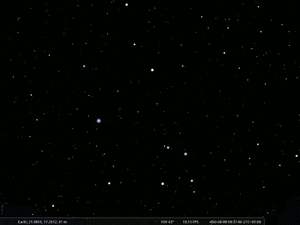Hasta: Difference between revisions
From All Skies Encyclopaedia
Hasta
No edit summary |
No edit summary |
||
| Line 1: | Line 1: | ||
{{DISPLAYTITLE:}} |
{{DISPLAYTITLE:Hasta (हस्त)}} |
||
[[File:13 Hasta draw.png|thumb|Hasta, the 13th nakshatra, as drawn in temples.]] |
[[File:13 Hasta draw.png|thumb|Hasta, the 13th nakshatra, as drawn in temples.]] |
||
[[File:13+14 stellarium.gif|thumb|Nakshatras 13 and 14, Hasta and Citra, marked on the Stellarium map (WGSN 2025).]] |
[[File:13+14 stellarium.gif|thumb|Nakshatras 13 and 14, Hasta and Citra, marked on the Stellarium map (WGSN 2025).]] |
||
Hasta (हस्त) is an Indian name, used by the Indian Vedic tradition. Most of these names are roughly 3000 years old. They pre-date Hinduism but were taken over by it. |
|||
==Etymology and History== |
==Etymology and History== |
||
'''Name Variants''' |
|||
* Hasta |
|||
* Kara, |
|||
* Ravibha |
|||
The term "Hasta" means "hand". Temple depictions show it with five stars, and it is identified with the five stars (β, α, ε, γ, and δ Corvi) of modern [[Corvus]] that form a remarkable and easily recognizable pattern in the night sky. |
The term "Hasta" means "hand". Temple depictions show it with five stars, and it is identified with the five stars (β, α, ε, γ, and δ Corvi) of modern [[Corvus]] that form a remarkable and easily recognizable pattern in the night sky. |
||
=== Origin of Constellation === |
=== Origin of Constellation === |
||
Revision as of 15:22, 13 October 2025
Hasta (हस्त) is an Indian name, used by the Indian Vedic tradition. Most of these names are roughly 3000 years old. They pre-date Hinduism but were taken over by it.
Etymology and History
Name Variants
- Hasta
- Kara,
- Ravibha
The term "Hasta" means "hand". Temple depictions show it with five stars, and it is identified with the five stars (β, α, ε, γ, and δ Corvi) of modern Corvus that form a remarkable and easily recognizable pattern in the night sky.
Origin of Constellation
Transfer and Transformation of the Constellation
Mythology
mnemonic tales and cultural significance
Weblinks
References
- References (general)






